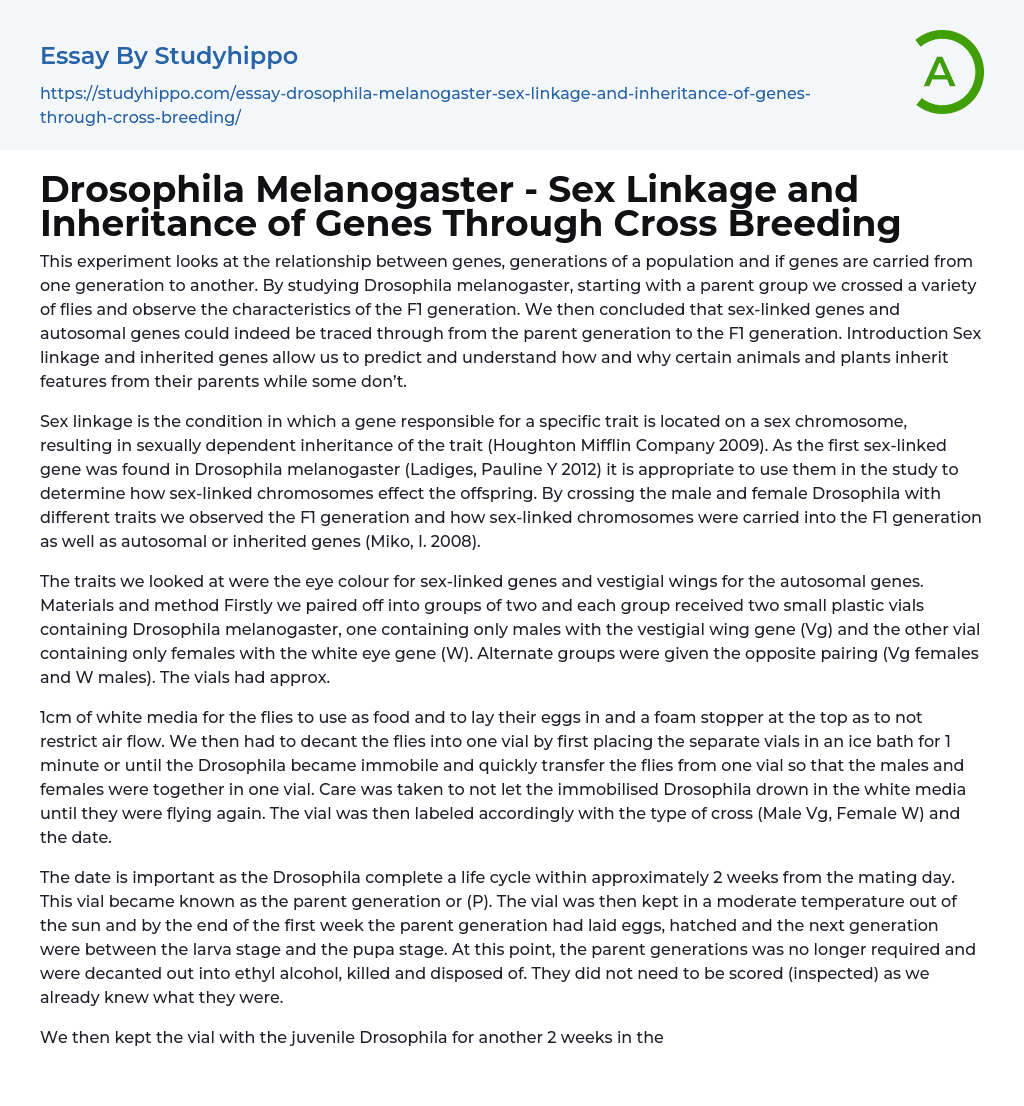

Drosophila Melanogaster – Sex Linkage and Inheritance of Genes Through Cross Breeding Essay Example
This experiment looks at the relationship between genes, generations of a population and if genes are carried from one generation to another. By studying Drosophila melanogaster, starting with a parent group we crossed a variety of flies and observe the characteristics of the F1 generation. We then concluded that sex-linked genes and autosomal genes could indeed be traced through from the parent generation to the F1 generation. Introduction Sex linkage and inherited genes allow us to predict and understand how and why certain animals and plants inherit features from their parents while some don’t.
Sex linkage is the condition in which a gene responsible for a specific trait is located on a sex chromosome, resulting in sexually dependent inheritance of the trait (Houghton Mifflin Company 2009). As the first sex-linked gene was fo
...und in Drosophila melanogaster (Ladiges, Pauline Y 2012) it is appropriate to use them in the study to determine how sex-linked chromosomes effect the offspring. By crossing the male and female Drosophila with different traits we observed the F1 generation and how sex-linked chromosomes were carried into the F1 generation as well as autosomal or inherited genes (Miko, I. 2008).
The traits we looked at were the eye colour for sex-linked genes and vestigial wings for the autosomal genes. Materials and method Firstly we paired off into groups of two and each group received two small plastic vials containing Drosophila melanogaster, one containing only males with the vestigial wing gene (Vg) and the other vial containing only females with the white eye gene (W). Alternate groups were given the opposite pairing (Vg females and W males). The vials had approx.
<
style="text-align: justify">1cm of white media for the flies to use as food and to lay their eggs in and a foam stopper at the top as to not restrict air flow. We then had to decant the flies into one vial by first placing the separate vials in an ice bath for 1 minute or until the Drosophila became immobile and quickly transfer the flies from one vial so that the males and females were together in one vial. Care was taken to not let the immobilised Drosophila drown in the white media until they were flying again. The vial was then labeled accordingly with the type of cross (Male Vg, Female W) and the date.
The date is important as the Drosophila complete a life cycle within approximately 2 weeks from the mating day. This vial became known as the parent generation or (P). The vial was then kept in a moderate temperature out of the sun and by the end of the first week the parent generation had laid eggs, hatched and the next generation were between the larva stage and the pupa stage. At this point, the parent generations was no longer required and were decanted out into ethyl alcohol, killed and disposed of. They did not need to be scored (inspected) as we already knew what they were.
We then kept the vial with the juvenile Drosophila for another 2 weeks in the same conditions as above and found that the F1 generation had hatched and laid eggs of their own. We then decanted the F1 generation into alcohol to kill them and kept them aside to score. The
vial containing the new generation F2 of Drosophila was then kept for use in a further experiment. The F1 generation that we had just decanted was then moved to a dissecting microscope for scoring, this generation included 20 Drosophila flies that we could then inspect for different traits using the microscope (traits being the sex of the fly, eye colour and wing type).
- Flowchart essays
- Integrated Circuit essays
- Tracking system essays
- Hard Disk Drive essays
- Male essays
- Same-Sex Marriage essays
- Masturbation essays
- Computer Components essays
- Computer Peripherals essays
- Personal Computer essays
- Dna essays
- Gene essays
- Addiction essays
- Anatomy and Physiology essays
- Biodegradation essays
- Cancer essays
- Dental Care essays
- Disability essays
- Disease essays
- Disorders essays
- Health Care essays
- Infectious Disease essays
- Inquiry essays
- Intelligence Quotient essays
- Lung Cancer essays
- Medicine essays
- Neurology essays
- Nutrition essays
- Olfaction essays
- Physical Exercise essays
- Public Health essays
- Sex essays
- Women's Health essays
- World health organization essays



